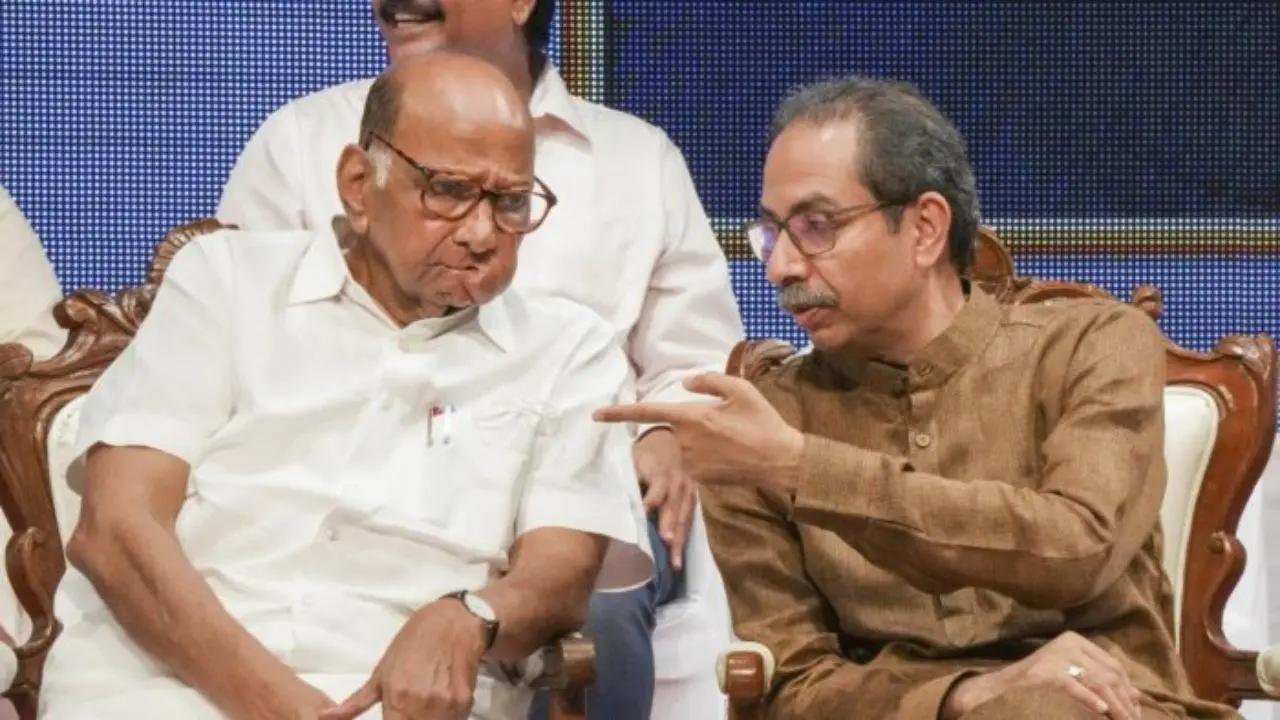Why battle for Maharashtra got interesting after splits in Shiv Sena, NCP?

The political landscape of Maharashtra has long been a theatre of dynamic alliances and strategic maneuvering. However, the upcoming Lok Sabha elections 2024 have injected a new level of intrigue into the battleground, courtesy of the splits within two formidable political entities: Shiv Sena and the Nationalist Congress Party (NCP).
Splits in key political parties Shiv Sena and NCP have made the battle for the 48 Lok Sabha seats in Maharashtra more interesting, besides the focus on traditional issues like unemployment and farmer suicides.
The Shiv Sena, a stalwart in Maharashtra politics, has traditionally aligned itself with Hindutva ideology and maintained a strong presence in the state. However, the fissures within the party resulting in the emergence of factions with differing ideologies have added a layer of complexity to the electoral scenario.
One faction of the Shiv Sena continues to uphold its alliance with the Bharatiya Janata Party (BJP), while another faction, the Shiv Sena (UBT), has opted for an alliance with Congress and Sharad Pawar-led NCP, citing ideological differences and dissatisfaction with the BJP-led government’s policies. This rift within the Shiv Sena has not only fragmented its voter base but has also opened up opportunities for rival parties to capitalise on the disarray.
Similarly, the Nationalist Congress Party (NCP), a key player in Maharashtra politics, has also witnessed internal divisions, particularly regarding leadership and strategy. Now, NCP is led by Maharashtra Deputy Chief Member Ajit Pawar, while the other faction – Nationalist Congress Party (Sharadchandra Pawar) – is led by Sharad Pawar. The fallout between factions within the NCP has led to speculation about its ability to retain its stronghold in the state.
The BJP-Shiv Sena won 41 of the 48 seats in the 2019 polls, but the Sena has split since and a vast majority of the Bal Thackeray-founded party is now allied with the BJP.
The NCP also split as well with Ajit Pawar joining the ruling alliance in the state, led by Eknath Shinde. In the 2019 Lok Sabha polls, the BJP emerged the top party with 23 seats, followed by the undivided Sena with 18. The undivided NCP had emerged victorious on four seats, the Congress one, while the AIMIM and an Independent accounted for the remaining two.
The factions
Uddhav Thackeray’s Shiv Sena is referred to as the ‘Shiv Sena (Uddhav Balasaheb Thackeray),’ while the rival faction led by Maharashtra Chief Minister Eknath Shinde is simply known as Shiv Sena. The Eknath Shinde-led Shiv Sena’s election symbol is the Bow and Arrow, whereas Shiv Sena (UBT) led by Uddhav Thackeray uses a flaming torch as its symbol.
Following the splits, the faction led by Ajit Pawar is now recognised as the Nationalist Congress Party, retaining the original party name and symbol. Founder and president Sharad Pawar formed the Nationalist Congress Party (Sharadchandra Pawar) after the Election Commission recognised the Ajit Pawar faction as the original party. The Sharad Pawar faction will contest both Lok Sabha and State Legislative Assembly polls under the party symbol of the `trumpet.`
What experts have to say?
The implications of these splits extend beyond mere intra-party dynamics. The fragmentation of these political entities has the potential to realign the political landscape of Maharashtra, giving rise to new alliances, power dynamics, and electoral strategies.
“In this context, the battle for Maharashtra in the Lok Sabha elections 2024 assumes heightened significance. The traditional political equations are being reshaped, and the outcome of this electoral contest will not only determine the composition of Maharashtra’s representation in the Parliament but also set the tone for future political developments in the state,” a political analyst said.
“The splits within Shiv Sena and NCP have injected uncertainty into the electoral calculus, making it imperative for all stakeholders to recalibrate their strategies and alliances. The political landscape is evolving rapidly, and every move made by the key players will be closely scrutinised for its potential impact on the electoral outcome,” he added.
As Maharashtra braces itself for the Lok Sabha elections 2024, the battle lines are being drawn, alliances are being forged, and political fortunes hang in the balance. In this high-stakes contest, the only certainty is the unpredictability that defines the ever-changing dynamics of Maharashtra politics.
While discussing the potential confusion among voters due to splits in parties like Shiv Sena and NCP, political analyst Abhay Deshpande suggested that Uddhav Thackeray and Sharad Pawar could garner sympathy votes. “There`s a factor at play here: both Uddhav Thackeray and Sharad Pawar hold the victim card, which could attract sympathy votes. As for confusion over party symbols, I don`t anticipate a significant issue because we`re in the age of social media,” he remarked.
“Detailed information is readily available to everyone. Political consciousness is high, so people are well-informed about the dynamics of Maharashtra politics. While some voters might experience confusion, I believe the percentage will be minimal,” Deshpande concluded.
What leaders have to say?
Shiv Sena (UBT) MP Arvind Sawant said that voters can distinguish between the real Shiv Sena and the fake. “Voters won`t be misled regarding their choice of party. The electorate is astute enough to discern which party and symbol deserve their vote. In this digital age, people are well-informed and aware of all political developments in Maharashtra. They know precisely which Shiv Sena is real. We don`t require validation from the Election Commission to authenticate our identity as the true Shiv Sena. We resonate in the hearts of the people, carrying forward the ideologies of Balasaheb Thackeray, and the public recognises that.”
NCP (Ajit Pawar faction) leader Sunil Tatkare stated that voters are now well-informed and won`t be confused between the real NCP and the fake once. “Voters are astute and aware of everything happening in the state and Maharashtra politics. I believe they can discern the real NCP from the fake,” he emphasised.
What younger generation thinks about Shiv Sena and NCP split
In the political landscape of Maharashtra, the recent rift within the Shiv Sena and the Nationalist Congress Party (NCP) has sent ripples through the socio-political fabric of the state. Traditionally, these two parties have been pivotal players, shaping the course of Maharashtra`s governance. However, as they part ways, it`s imperative to explore how the younger generation perceives this split and what it signifies for the future of Maharashtra`s politics.
For many young individuals, political affiliations are not merely inherited but rather subject to scrutiny based on ideology, policy, and performance. The Shiv Sena and NCP, both entrenched in Maharashtra`s political scene for decades, have garnered varied perceptions among the youth.
The Shiv Sena, once synonymous with staunch Marathi nationalism and Hindutva ideology, has been undergoing a metamorphosis, especially since its alliance with the Indian National Congress and the Nationalist Congress Party to form the Maha Vikas Aghadi government in Maharashtra in 2019. This alliance marked a departure from its historical partnership with the Bharatiya Janata Party (BJP). For some younger individuals, this shift signifies an adaptability to changing political realities, while for others, it raises questions about the party`s core principles and opportunistic alliances.
“The leadership transition within the Shiv Sena, with Uddhav Thackeray taking the reins after the demise of his father Bal Thackeray, has intrigued the younger generation. Uddhav`s leadership style, often perceived as more moderate compared to the aggressive rhetoric of the party`s past, has garnered both praise and criticism. Some view it as a sign of pragmatism and a willingness to engage in coalition politics, while others see it as a dilution of the party`s original ethos,” Jay Shah, a Girgaon resident, said.
In contrast, the NCP, under the leadership of Sharad Pawar, has been perceived as a seasoned player in Maharashtra`s political arena. Pawar`s political acumen and ability to navigate complex alliances have earned him respect across generations. The NCP`s decision to break away from the Shiv Sena-led coalition government reflects its strategic calculations and desire to maintain its distinct identity.
“Among the younger generation, there is a nuanced view of the NCP. While some admire Pawar`s political astuteness and the party`s focus on development issues, others criticise its dynastic politics and alleged involvement in corruption scandals. The splits within the Shiv Sena and NCP has prompted discussions about both parties future trajectory and its potential alliances in the upcoming elections,” Jay addded.
The splits within the Shiv Sena and NCP holds significance for the younger generation beyond immediate political ramifications. It underscores the evolving nature of coalition politics and the emergence of new fault lines within Maharashtra`s political landscape.
“For many young voters, this split serves as a reminder of the importance of critically evaluating political decisions and holding parties accountable for their actions,” Rita Todankar said.
She further said the split opens up space for new political actors and alternative ideologies to emerge. As the traditional power dynamics undergo transformation, there is an opportunity for youth-led movements and grassroots initiatives to shape the discourse and demand greater transparency and accountability from political parties.
“As Maharashtra gears up for future elections, the split within the Shiv Sena and NCP sets the stage for a realignment of political forces. While alliances may shift, and strategies may evolve, the voices of the younger generation will play a crucial role in shaping the direction of Maharashtra`s politics. Their demands for inclusive governance, sustainable development, and social justice are poised to reshape the political landscape, challenging established narratives and paving the way for a more dynamic and responsive democracy,” Rita said.
When asked if the Shiv Sena and NCP splits will confuse voters, she said the voters won`t be confused. “In this digital era, with every party reaching to voters digitally people are well aware about which person represents which party,” Rita added.

Atul Tiwari is a seasoned journalist at Mumbai Times, specializing in city news, culture, and human-interest stories. With a knack for uncovering compelling narratives, Atul brings Mumbai’s vibrant spirit to life through his writing.





